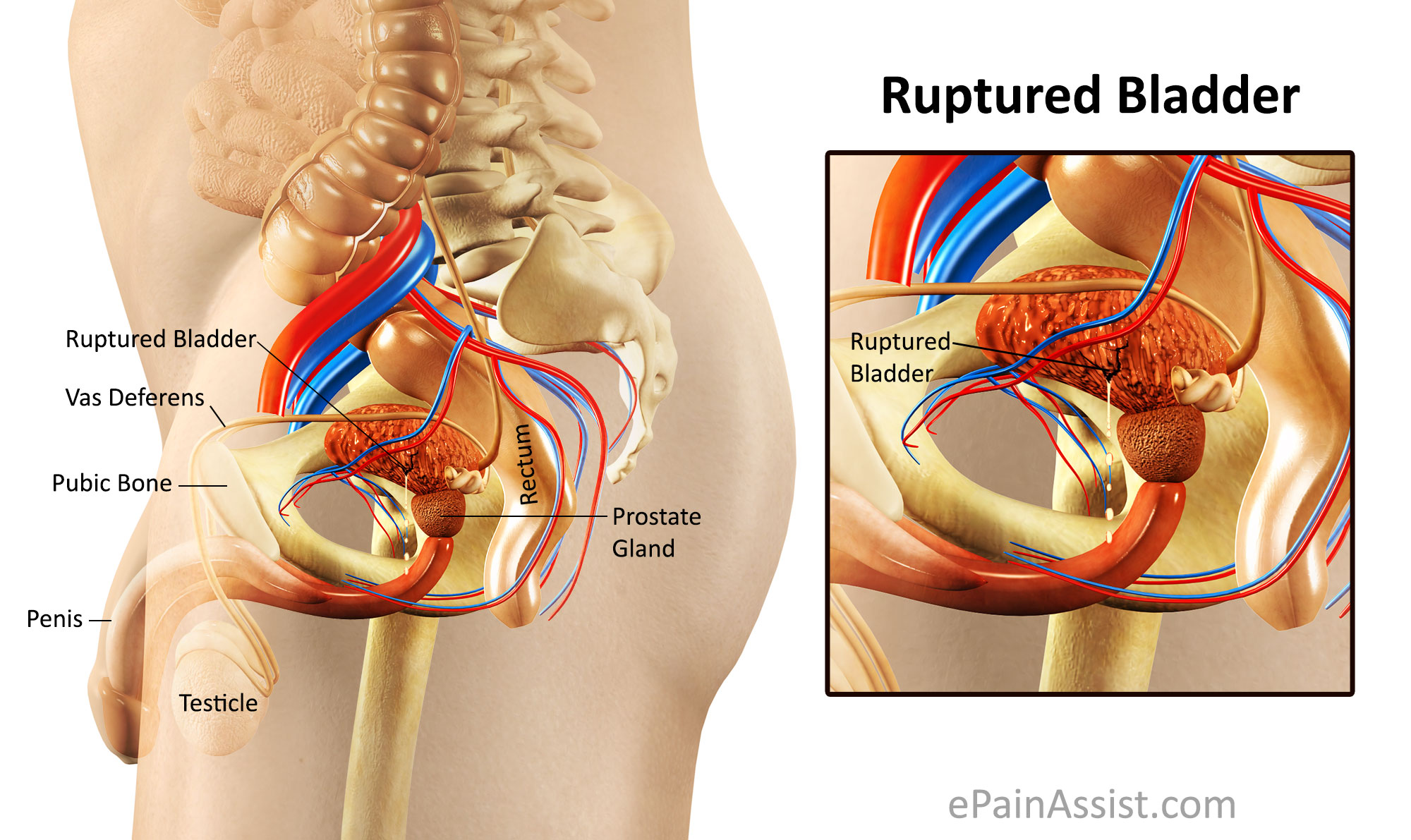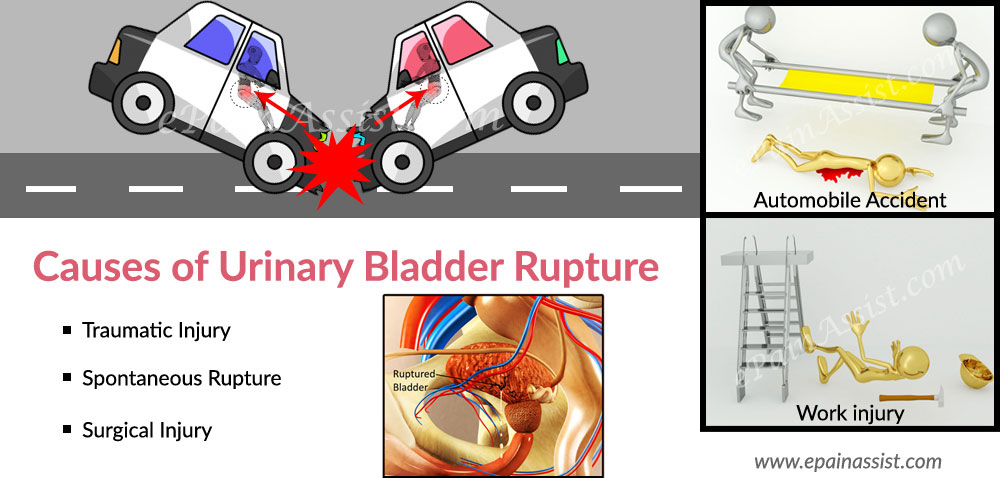Urinary Bladder Rupture may occur as a result of a trauma to the lower abdomen or pelvis. Traumatic injury is often seen following domestic fall, work injury or automobile accident. Most severe bladder injury occurs when bladder is filled with urine. In this article, we will discuss about the various causes, symptoms and treatments rendered for Urinary Bladder Rupture.
How Is Urinary Bladder Rupture Defined?
- Urinary Bladder Rupture is generally caused by a direct blow or penetrating trauma to the urinary bladder.
- The probability of bladder rupture is variable. A urinary bladder that is full is more prone to rupture than an empty one.1
- In the past diagnosis of Bladder Rupture was often missed or delayed.
- Prognosis is excellent following early diagnosis with adequate medical and surgical measures.
- Early suspicion of Urinary Bladder Rupture, adequate radiological procedures, and immediate surgical intervention if indicated can successfully treat Bladder Rupture with least complications.
Urinary Bladder Rupture Due to Traumatic Injury
a. Injury- 82% of the cases of bladder rupture are caused by injuries.
- Blunt injury of lower abdomen and pelvis caused by
- Domestic injury
- Work injury
- Automobile accident
- Assault
- Penetrating Injury of lower abdomen and pelvis caused by-
- Domestic injury
- Work injury
- Automobile accident
- Assault
- Gunshot wound
- Surgical trauma
- Obstetric trauma
b. Alcohol or Drug Intoxication-
- Domestic injury and fall causes
- Blunt trauma
- Penetrating trauma
Spontaneous Rupture-
- Spontaneous rupture is rare and causes less than 2% of the bladder rupture.
- Injury is associated with extraperitoneal bleeding
Urinary Bladder Rupture Due to Surgical Injury
- Prostate surgery
- Colorectal surgery
- Cesarean section
- Cancer Surgery of uterus, vagina, ovary, rectum and sigmoid colon.
Types of Urinary Bladder Rupture
a. Intraperitoneal Rupture2
- Less common injury- 15% of the bladder tears are intraperitoneal rupture.
- Mostly observed following penetrating injury or blunt injury following direct blow to the distended bladder.
- Cystogram (dye injection in urinary bladder) demonstrates spread of contrast material around bowel.
b Extraperitoneal Rupture3
- Common type of injury- 85% of bladder tear are extraperitoneal rupture.
- Associated with fracture of pelvis
- CT scan and MRI shows extravagated contrast dye injected in urinary bladder, confirms the diagnosis.
c. Combine Rupture
- Cystogram and dye study shows findings of intra and extra peritoneal rupture.
Symptoms of Urinary Bladder Rupture
Pain
- Suprapubic pain
- Suprapubic tenderness
- Pain secondary to pelvic bone fracture
Gross Hematuria
- Bleeding from urinary bladder following fracture causes extra or intraperitoneal loss of blood.
- Intraperitoneal bladder rupture is often presented as renal failure.2
- Bleeding also causes frank hematuria.
- Red urine suggests possible rupture bladder.
Retention of Urine
- Bleeding following bladder rupture may result in bladder tamponed. Bladder tamponed is caused by blood clot blocking urine output into urethra.
Hypotension (Low Blood Pressure)
- Severe blood loss causes hypotension
Tachycardia (Increase heart rate)
- Low blood volume causes increased heart rate.
Restless
- Low blood pressure causes restlessness and agitation.
Abdominal Distension Is Caused By-
- Intraperitoneal bleeding
- Constipation
- Paralytic ileus- bowel movement is lost and bowel is distended
Pelvic Fracture
- Causes pelvic pain and tenderness
Scrotal Hematoma
- Bladder rupture causes extraperitoneal hemorrhage, which often trickles into scrotum.
Diagnosis Of Urinary Bladder Rupture
Cystogram
- Dye is injected in to bladder
- Dye intraperitoneal and extraperitoneal dye spread examined using X-Ray or CT scan.
Cystoscopy
- Endoscopy study is performed to visualize inner surface of the bladder.
- Bladder rupture and bleeding is seen during the procedure.
- Minor injury is often repaired during examination.3
Radiological Examinations4
CT Scan
- CT scan study with dye was performed to evaluate function and injury of kidney, ureter, bladder and urethra.
Magnetic Resonance Imaging (MRI)
- MRI study with dye was performed to evaluate function and injury of kidney, ureter, bladder and urethra.
Intravenous Pyelogram
- Also known as excretory urogram
- Dye is excreted by kidney
- Study is performed to evaluate function of kidney
- Pyelogram also indicates the extraperitoneal and intraperitoneal dye leak.
Ultrasound Examination Of Urinary Bladder5
- Ultrasound study is performed with and without dye injection. The ultrasound images are examined for area of rupture and hematoma.
Urine Examination
- Hematuria
- Frank blood discharge in urine
Blood Examination
- Hemoglobin- low
- Red blood cell count- low
- Electrolytes, BUN and Creatinine- normal level.
Treatment For Urinary Bladder Rupture
Fluid Management for Urinary Bladder Rupture
- Intravenous fluid management
- Blood transfusion
Medication for Urinary Bladder Rupture
- Analgesics- NSAIDs or opioids are prescribed for pain depending on intensity of pain
- Prophylactic antibiotic if injury is caused by penetrating injury.
Surgery for Urinary Bladder Rupture
- Emergency
- Severe bleeding is observed during cystoscopy
- Continuous discharge of frank blood through urethra.
- Extraperitoneal rupture of urinary bladder is repair during cystoscopy.3
- Elective
References
1. Evaluation and treatment of bladder rupture.
Bodner DR1, Selzman AA, Spirnak JP.
Semin Urol. 1995 Feb;13(1):62-5.
2. Intraperitoneal bladder rupture mimicking acute renal failure
K. G. Arun, Salahauddin, V. Leela, J. Noel, K. Venkatesh, S. Ramakrishnan, and
R. Dilip
3. Laparoscopic repair of extraperitoneal urinary bladder rupture after blunt abdominal trauma.
Tsai CH1, Wang YC, Wu SC, Hsieh CH.
Am Surg. 2012 Sep;78(9):E385-6.
4. Radiographic evaluation of suspected bladder rupture following blunt trauma: critical review.
Iverson AJ1, Morey AF.
World J Surg. 2001 Dec;25(12):1588-91.
5. Sonography of traumatic rupture of the bladder: “bladder within a bladder” appearance of extraperitoneal extravasation.
Kauzlaric D, Barmeir E. J Ultrasound Med. 1986 Feb;5(2):97-8.


